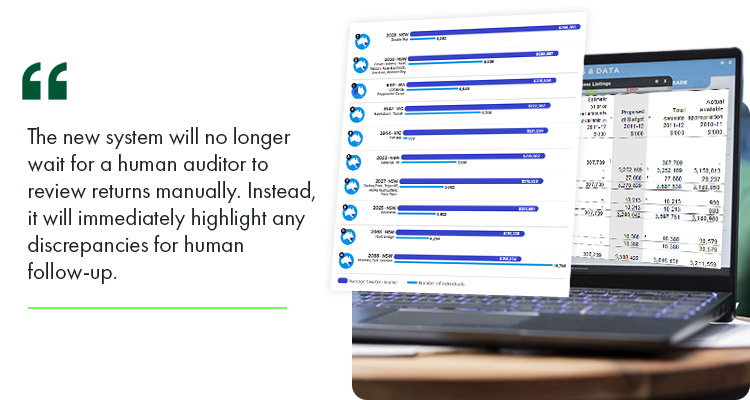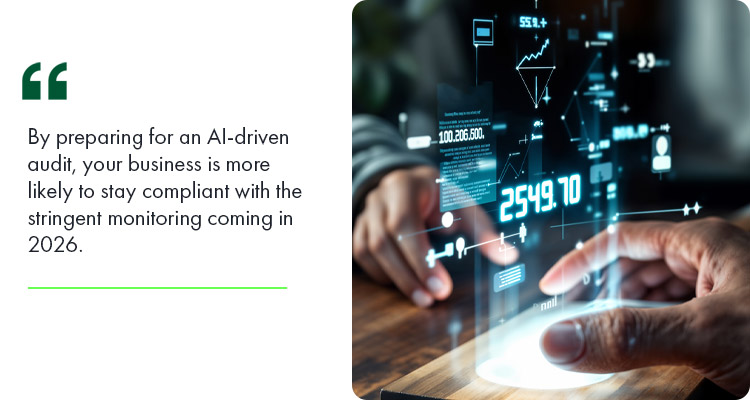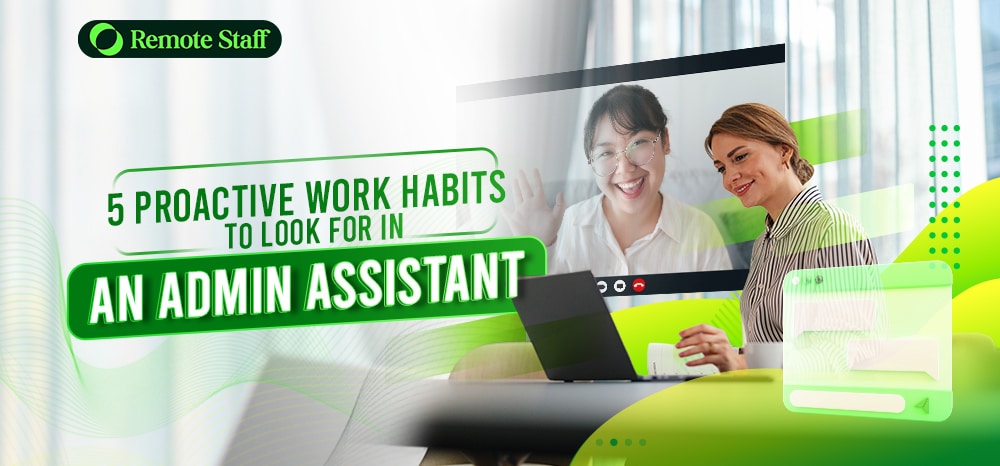Artificial intelligence (AI) is seeping into every corner of modern life, from image generation to work processes and even taxation compliance and risk assessment.
On this note, the Australian Taxation Office (ATO) is undergoing a major transformation, setting stricter compliance requirements powered by AI and algorithms. This means millions of financial records can now be checked automatically, and almost instantly.
In this article, we will discuss what this means for Aussie business owners in the next fiscal year – and the necessary steps they should take to prepare for these data-driven audits.
Read on to know more.
What is the ATO’s New Data-Driven Audit System?
As Australia’s principal revenue collection agency, the ATO uses various measures to maximise and speed up the collection process. Beginning in 2026, it will strengthen these efforts by using AI and machine learning.
Why the 2026 Crackdown is Different
Unlike previous simple data-matching methods, the ATO will begin using sophisticated AI models trained on historical data. This will help the agency establish benchmarks for specific occupations and industries.
As such, when a taxpayer lodges a return, the system will instantly compare their claims, such as work-related expenses and income-to-asset ratios, against those of their peers.
Then, the AI-driven system, combined with machine learning, will use historical data to check for any significant or unusual deviations from these benchmarks. If it detects one, it will trigger an instant risk score.

Where the ATO Gets Its Data
The new system will no longer wait for a human auditor to review returns manually. Instead, it will immediately highlight any discrepancies for human follow-up.
So, where will the ATO get the data it uses as a benchmark?
The government agency will rely on various sources, cross-referencing an interconnected network of over 60 data-matching programs, including:
- Banks and Major Lenders – The ATO receives mandatory reports on all interest income paid and all international money transfers above specified thresholds.
- POS Systems and Payment Platforms – Payment platforms like Stripe and PayPal, along with POS systems like Square and Tyro, also report transaction data, giving the ATO an almost real-time view of gross sales.
- eCommerce Platforms – Even major platforms like Amazon, eBay, and Shopify provide the ATO with comprehensive data on sellers, including total annual turnover and transaction volumes.
- Payroll and STP Phase 2 – Meanwhile, Single Touch Payroll (STP) Phase 2 requires employers to break down an employee’s gross income into detailed components. This covers salary, allowances, paid leave, and bonuses, making it easier to detect errors while ensuring payroll compliance auditing.
- B Crypto Exchanges – Lastly, the ATO’s Crypto Asset Data-Matching Program legally requires Australian crypto exchanges to report detailed transaction information. This includes historical and current data on all trades, deposits, and withdrawals. This allows the ATO to calculate Capital Gains Tax (CGT) liabilities and identify other unreported income.
Top Audit Triggers the ATO is Watching Closely in 2026
With all these information sources, the Australian Taxation Office can easily monitor compliance and flag transactions that appear suspicious based on its benchmarks.
Consequently, any errors or miscalculations can be costly for a business, as non-compliance or violations may lead to significant financial or legal problems.
So, what steps should every business take to prepare?
Clean Up Bookkeeping and Reconciliation
Daily or weekly reconciliation is now essential.
Infrequent bookkeeping creates the very discrepancies that machine learning systems are designed to flag. Thus, it’s best to conduct regular bookkeeping to correct duplicates, resolve mismatches, and locate missing invoices.

Regularly cleaning up your books ensures that reported data is accurate, helping prevent AI from flagging your business for unnecessary audits.
Align All Data Sources
Machine learning and AI algorithms look for a “perfect alignment” between all reporting systems for your income and your official tax filings.
Logically, any discrepancy is immediately flagged as a high-risk anomaly. Therefore, make sure all your data sources, from POS systems to e-commerce and payroll platforms, are aligned and consistent.
Otherwise, any discrepancies will trigger tax compliance alerts, prompt investigations, and become an immediate red flag for an ATO auditor.
Review Deductions and Substantiation
Keep receipts for everything.
Always maintain valid tax invoices or receipts for every claimed expense. Use digital scans or cloud storage to ensure you have supporting documents for every dollar in case of an audit.
In addition to receipts, keep contemporaneous logs to justify the business-related portion of each expense.
For example, for motor vehicle expenses, a continuous 12-week period each year is required to establish the business use percentage of your vehicle. AI systems are highly effective at cross-checking declared fuel and maintenance costs against the reported business percentage, so it’s essential to have accurate data and logs to support your claims.
Ensure Correct Worker Classification
The recent Joanna Pascua controversy also brought worker classification into focus for the Australian Taxation Office.
In that case, Pascua was classified as an independent contractor but performed the duties of an employee. When she filed a complaint, the Fair Work Commission (FWC) ruled in her favor, leading to costly tax and compliance issues for her employer.
The ATO identifies misclassifications by cross-checking payments reported to contractors against missing Superannuation Guarantee (SG) contributions and absent STP reporting.
As a result, in addition to proper accounting and bookkeeping, many Aussie employers use Employers of Record, who act as the legal employer for their remote workers.
How to Stay Fully Audit-Ready in 2026
Aside from understanding the trigger factors, you also need to focus on proactive issue identification by taking the following measures:
Step 1: Automate Where Possible.
Manual processes are prone to errors and can create data lags, which the ATO’s real-time systems are designed to detect and penalise.
Therefore, automating your core financial tasks can help ensure your records align with the data the ATO receives, using the following:
- Xero Bank Feeds and Equivalent Systems – Using platforms like Xero, QuickBooks, or MYOB allows you to automatically import daily transactions from your bank account, reducing the risk of missing entries or transcription errors.
- Auto-Reconciliation Tools – Use tools provided by these accounting platforms to automatically match bank transactions with invoices or bills, ensuring more accurate monthly reconciliations.
- Real-Time Payroll Systems – Use modern, cloud-based payroll systems like Xero Payroll or MYOB to transmit payroll information to the ATO in real time with every pay run.
Step 2: Conduct Quarterly Internal Reviews.
Stay ahead of the ATO’s continuous, AI-driven monitoring by conducting quarterly internal compliance and having structured data reviews. Here’s how:
- BAS Accuracy – Before lodging each Business Activity Statement (BAS), carefully cross-check the reported gross income and GST collected or paid against your accounting software’s ledgers and the data reported by third parties.
- Payroll Compliance – Conduct a detailed review of your STP data and Superannuation Guarantee obligations each quarter. Verify that the correct amounts have been withheld, SG payments are made on time, and employee classifications in your payroll system align with the data reported to the ATO.
- Deduction Legality and Substantiation – Review a sample of your largest expense claims each quarter to ensure they are genuinely business-related and supported by the necessary logbooks and receipts. This way, you can immediately identify and remove any unsupported claims before submitting them in a BAS or annual tax return.
Step 3: Hire Skilled Remote Finance Staff.
The ATO’s 2026 crackdown guidelines can be time-consuming, given all the cross-checking and referencing required. For small and medium business (SMB) owners, keeping track of everything can be challenging while also managing day-to-day operations.
Thus, many SMBs choose to outsource accounting and bookkeeping to skilled professionals who can manage these tasks efficiently. These include:
- Accountants and Bookkeepers – They manage bank feeds, code transactions accurately, and perform the real-time reconciliations needed to prevent AI from flagging errors.
- Payroll Specialists – They ensure every worker classification is correct, payments are calculated accurately, and all data is transmitted to the ATO correctly and on time.
- Data and Reconciliation Admins – They are responsible for aligning data feeds from third-party sources, ensuring that gross sales reported by POS systems match the figures in the accounting software.
Together, these professionals allow your business to comply with all ATO requirements without the hassle – and reduce the risk of audits.
Frequently Asked Questions (FAQs)
Here are some frequently asked questions about the ATO audit crackdown coming in 2026.
#1. What Industries Will Be Targeted First?
The ATO will primarily focus on sectors with high cash transactions or those where income is often under-reported, such as:
- Gig and sharing economy;
- Construction and trades;
- Hospitality and retail;
- Cryptocurrency.

#2. Are Small Businesses More At Risk Than Big Ones?
Yes. Small businesses make up the largest share of unpaid taxes in Australia, making them a key focus for the ATO’s compliance efforts.
Thus, SMBs must ensure their bookkeeping and reporting systems align with all submissions to avoid audits and scrutiny, especially now that the ATO will use industry benchmarks.
#3. Will the ATO Audit Cash Businesses More Aggressively?
Yes. With AI, the ATO becomes more aggressive and effective in targeting the “shadow economy” – income that is not reported or taxed.
For example, if a cash-based takeaway shop reports a profit margin or wages expense significantly below the industry average, AI will instantly flag this discrepancy as high risk for undeclared cash income.
#4. How Often Does the ATO Check eCommerce Accounts?
With AI, the ATO will shift from annual reviews to near real-time compliance checks.
Once the annual data is collected, the ATO’s AI and machine learning engine will perform continuous, automated cross-checks.
As soon as you lodge your BAS or annual tax return, the AI will instantly match your declared income against the total turnover reported by your platforms.
In short, although the source data is collected annually, AI algorithms enable continuous checks against your lodgments.
#5. Do I Need A Tax Agent AND A Bookkeeper?
Yes. A bookkeeper is your first line of defense, providing audit insights and ensuring the data monitored by AI is accurate. The tax agent acts as the second line of defense, making sure the final return is legally correct and offering strategic advice.
However, if your budget is limited, you can outsource a bookkeeper for the time being or hire a remote accountant with tax filing experience. This allows you to address both accounting and tax compliance.

Conclusion: Staying Ahead of the ATO’s Data-Driven Future
Artificial intelligence is becoming a part of everyday life, and now it’s extending to tax compliance. Thus, businesses, like other sectors, must adapt.
By preparing for an AI-driven audit, your business is more likely to stay compliant with the stringent monitoring coming in 2026. Keep receipts, double-check transactions, use automation, and hire skilled professionals to manage these processes.
Don’t wait until tax time to start preparing. Hire skilled bookkeeping and ATO compliance specialists now to secure your data and safeguard your future.
If you’re unsure where to start, call us today or request a callback so we can help you get started.
Syrine is studying law while working as a content writer. When she’s not writing or studying, she engages in tutoring, events planning, and social media browsing. In 2021, she published her book, Stellar Thoughts.





















